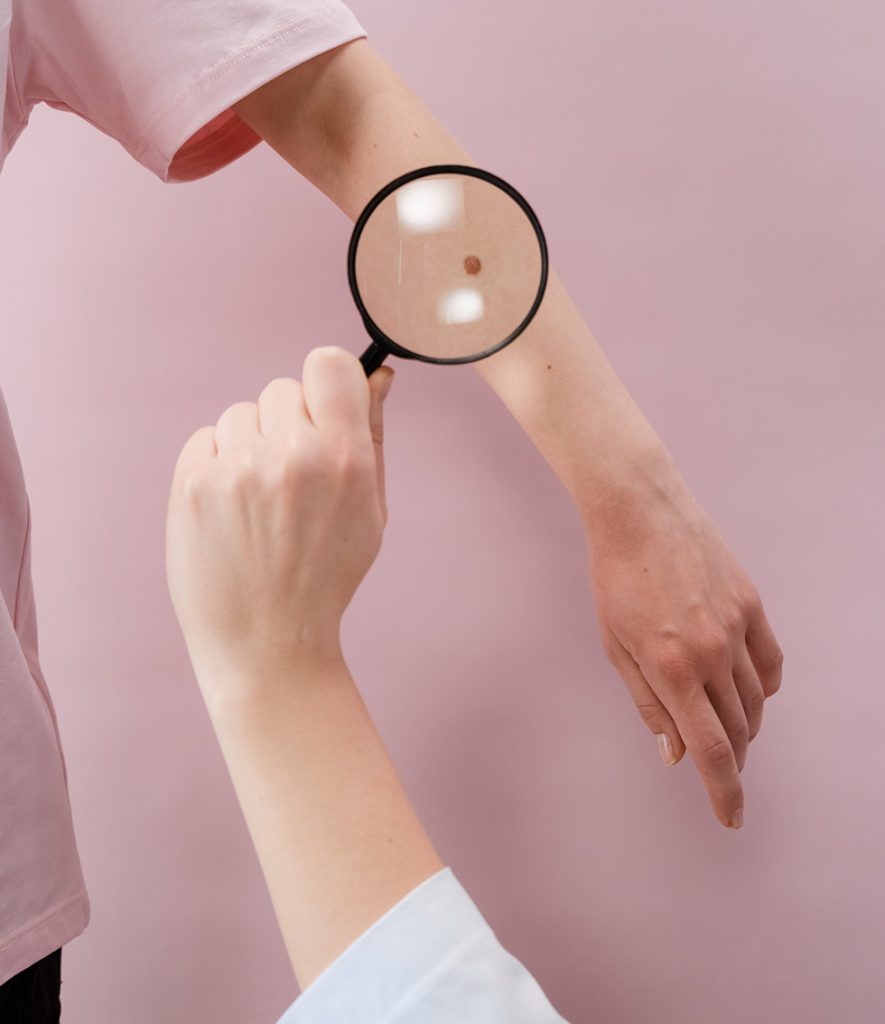Visit an experienced eczema specialist for effective management of your eczema.
Visit an experienced eczema specialist for effective management of your eczema.
Blog Article
In-Depth Dermatology Knowledge: Resolving Acne Issues, Mole Concerns, and Eczema Effects
When it comes to skin health, detailed dermatology expertise is vital; it empowers individuals to tackle typical skin problems such as acne, mole abnormalities, and dermatitis with self-confidence. Recognizing acne therapies, recognizing potential skin cancer check in moles, and taking care of dermatitis triggers can considerably enhance skin health and wellness - skin cancer check. This write-up will certainly discover these subjects, using an informative check out the science behind these typical skin issues - an exploration that promises to enlighten and educate
Recognizing the Essentials: What Is Acne, Moles, and Dermatitis?
While many individuals might be familiar with the terms acne, moles, and eczema, recognizing what they in fact are is a various issue completely. Acne is a skin problem identified by inflamed or contaminated oil glands, typically noticeable as acnes or areas, mainly on the face, back, and breast. Moles, on the other hand, are small skin growths brought on by clusters of pigmented cells; they can show up anywhere on the body and vary in color and dimension. Finally, dermatitis, likewise referred to as atopic dermatitis, is a persistent problem triggering irritated, itchy skin, typically taking place in action to toxic irritants or irritants. While these problems prevail, they can have differing degrees of seriousness and impact on a person's life.
The Scientific research Behind Acne: Causes, Types, and Therapies
The complex scientific research behind acne starts with comprehending its formation device. This complex procedure, influenced by different variables, leads to different kinds of acne. The short article will also touch upon effective therapies readily available to manage and treat this typical skin disease.
Acne Formation System
An overwhelming bulk of people will certainly experience the common skin condition understood as acne at some point in their lives. Acne development begins with the overflow of sebum, an oily substance produced by sebaceous glands in the skin. When these clogged up pores ended up being infected with Propionibacterium acnes, a germs naturally existing on the skin, swelling happens, resulting in visible acne.

Effective Acne Therapies
Almost every person will certainly grapple with acne at some factor, making a clear understanding of efficient acne therapies essential. Various treatments target different aspects of acne, such as inflammation, oil production, and microorganisms. It's important to remember that not all treatments will certainly function for every person, as acne's reasons and intensity differ.
Mole Issues: Identification, Assessment, and When to Seek Medical Attention
Moles, common skin developments, call for mindful recognition and routine evaluation for optimal skin health (acne treatment). Recognizing the normal appearance of one's moles, in addition to any type of modifications that may occur, is crucial. Prompt clinical interest ought to be sought when particular indications, which will be discussed, are detected
Recognizing Mole Recognition
Exactly how does one compare a safe mole and one that may call for clinical attention? First, recognizing the features of typical moles is essential. A regular mole is normally round or oval, has a smooth side, and is no bigger than 6mm in diameter. The shade must correspond and can vary from pink, tan, brownish, or black. Moles usually appear during youth or adolescence, and by their adult years, most individuals have between 10 to 40 moles. Nonetheless, moles that transform in dimension, shape, or color, end up being itchy or hemorrhage, or appear after age 30 can be startling. These abnormalities don't instantly suggest skin cancer cells but are reasons to consult a skin specialist. Understanding mole identification is the initial step in skin health and wellness monitoring.
Performing Normal Mole Evaluations

Recognizing Essential Medical Signs
When should one look for clinical attention worrying moles? It is necessary to speak with a dermatologist when abnormal attributes are observed. These might include crookedness, uneven borders, varying shades, a diameter larger than 6mm, or developing size, form, or color. Understood as the ABCDE's of mole examination, these adjustments may indicate have a peek at these guys malignant cancer malignancy, a fatal type of skin cancer cells. Furthermore, any kind of bleeding, itching, or non-healing sores connected with moles require prompt medical interest. A person should likewise beware if new moles appear after the age of 30 or if there's an unexpected boost in the variety of moles. Regular self-examinations coupled with professional analyses guarantee very early detection and effective treatment of prospective skin abnormalities.
Eczema Explained: Causes, Signs And Symptoms, and Managing Flare-Ups
Although eczema may show up as a straightforward skin irritation to the untrained eye, it is, in reality, a complex dermatological condition with a plethora of potential reasons. Dermatitis, additionally referred to as atopic dermatitis, is generally triggered by a mix of hereditary and ecological variables. Managing eczema usually includes recognizing and staying clear of triggers, maintaining a good skin care routine, and using prescribed treatments.
Practical Skin Care Tips to Stop and Handle Acne, Moles, and Dermatitis
Recognizing and resolving skin problem such as acne, moles, and eczema require useful and efficient skin treatment routines. Routine cleaning with mild, non-irritating items aids keep skin health and prevent acne. Sunscreen application decreases mole danger and lessens dermatitis flares caused by sunlight exposure. Moisturizing, especially for those with dermatitis, is crucial to keep skin hydration and barrier function. A balanced diet plan abundant in anti-oxidants can improve skin health and wellness and reduced swelling, potentially minimizing acne and eczema intensity. Routine skin checks aid in early mole discovery, possibly preventing skin cancer cells. While these pointers can mitigate skin troubles, they're not a replacement for professional dermatological guidance. Always speak with a dermatologist for persistent or severe skin disease.
Professional Dermatology Treatments: An Introduction of Modern Solutions
What are the modern-day options used by professional dermatology treatments? Skin specialists today have a wide array of effective therapy choices to deal with numerous skin disease. For acne, retinoids and anti-biotics are prescribed to control the problem, while chemical peels and laser treatment are made use of for serious cases. With moles, expert elimination is carried out if they present a health risk. This can be done with medical excision or laser elimination. On the other hand, eczema is usually treated with topical corticosteroids to handle signs, and photo-therapy for persistent situations. other Furthermore, innovations in biologics have shown guarantee in treating serious dermatitis. All these therapies are under the specialist guidance and care of skin specialists, making sure secure and reliable monitoring of skin problem.
Final thought
Comprehending dermatological worries like acne, mole irregularities, and eczema is vital for effective therapy. Acne monitoring needs understanding of different treatment choices, while mole evaluation can result in early discovery of skin cancers cells. Dermatitis administration includes determining triggers and executing appropriate treatments. Comprehensive dermatology understanding is important for preventing and taking care of these skin conditions, stressing the need for specialist skin specialist care to improve skin health.
Report this page